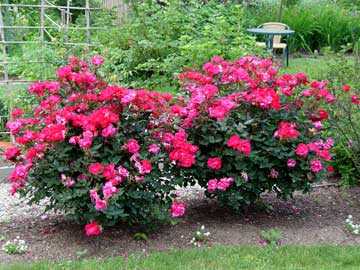Tips for Growing Great Roses
 Shrub-type roses such as these best-selling Knock Outs grow well and bloom for months with no more care than a basic shrub.
Shrub-type roses such as these best-selling Knock Outs grow well and bloom for months with no more care than a basic shrub.
© George Weigel
Don’t shy away from roses because they’re supposedly finicky and hard to grow. While those gorgeous single roses at the end of a long stem usually do take care and experience to grow to perfection, many other types are as easy to grow as a basic shrub.
Take a look at types known as shrub, landscape or groundcover roses, which grow on multi-stemmed bushes and produce lots of smaller but colorful flowers over a long period – sometimes all summer into fall. Most of these grow well with minimal care and time.
Roses labeled as “antique,” Old English or David Austin are among others that grow easily with larger flowers and can be quite fragrant. Thanks to improvements in breeding, even many new varieties of the more elegant hybrid tea, grandiflora and floribunda types perform better with less disease and “babying” than older varieties.
Site: All roses do best in full-sun locations – at least 6 to 8 hours of direct sun a day. They also prefer loose, rich and well drained soil – not hard-packed clay or soggy spots. Work a bucket full of compost into the loosened soil around each plant if your soil isn’t good. Soak the ground well after planting, and keep the soil consistently damp the whole first season to help those young roots grow. After that, shrub/ landscape/ groundcover types often do well with no care other than occasional pruning to control the plants’ size.
Water: To milk the most out of them, though – or if you want to give other types a try – figure on soaking the ground once or twice a week when the weather is hot and dry. Although roses are fairly drought-tough plants, they grow and bloom best in moist but never-soggy soil. A 2 inch layer of mulch helps keep the soil moist and weeds from growing. Bark, pine needles, compost, leaves and/or grass clippings are all good mulch choices.
Feed: Roses are also “hungry” plants that benefit from a regular scattering of a granular fertilizer rich in natural and organic nutrients. Fertilize from when the season’s first leaves appear until about 6 weeks before fall’s first frost typically occurs. Then knock off the feeding until the following year.
Trim: Snip or trim flowers after they brown throughout the season. Although nothing bad will happen if you don’t, this "deadheading" neatens the plants and encourages more flower buds to form. The best time for bigger size-control cuts to rose bushes is toward the end of winter. Get the job done before buds on the stems start producing leaves, and don’t be afraid to cut back hard – even back to a foot tall – to keep your plants compact.